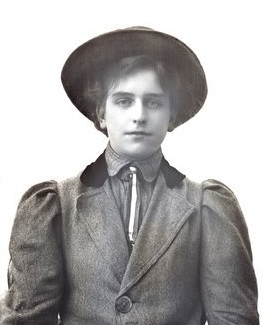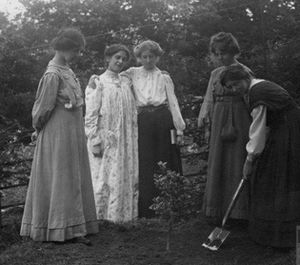Vera Wentworth facts for kids
Quick facts for kids
Vera Wentworth
|
|
|---|---|
 |
|
| Born |
Jessie Alice Spink
June 1890 St. Margarets, Westminster, London, Middlesex, England
|
| Died | 5 August 1957 Elizabeth Garrett Anderson and Obstetric Hospital, London, England
|
| Nationality | British |
| Education | St Andrews University |
| Partner(s) | Daisy Ethel Carden |
| Relatives | Harry Laing Spink (Father), Rachel Amanda Spink (nee Goode - Mother), William Wilfrid Spink (Brother) |
Vera Wentworth (born Jessie Alice Spink; 1890 – 1957) was a brave British woman who fought for women's right to vote. She was a suffragette, which means she believed women should have the same voting rights as men. Vera went to prison for her beliefs and even went on hunger strike, where she was force-fed. She also directly challenged the Prime Minister more than once to make her voice heard. She wrote a book about her time in prison called "Three Months in Holloway."
Contents
Vera Wentworth: A Champion for Women's Votes
Early Life and Joining the Fight
Vera Wentworth was born in 1890. After finishing school, she started working in a shop. She soon became active in trade unions, which are groups that work to protect workers' rights.
In 1907, Jessie Alice Spink officially changed her name to 'Vera Wentworth'. The next year, in 1908, she joined the Women's Social and Political Union (WSPU). This group was famous for its strong actions to get women the right to vote. Soon after joining, Vera was arrested during a protest outside the House of Commons, which is where the British government meets. She was sentenced to six weeks in prison. She even had to stay an extra day because she carved "votes for women" into her cell wall!
When she was released, Vera became good friends with Mary Blathwayt, another important suffragette. Vera was very energetic and even joined a secret group within the WSPU called the "Young Hot Bloods." This group promised to take on "danger duty" for women's suffrage. Only Emmeline Pankhurst, a leader of the suffragette movement, was allowed to attend their meetings. Some older suffragettes even affectionately called Vera "the young hooligan we know" because of her spirited nature.
In June 1908, Vera was arrested again for protesting outside the House of Commons. This time, she was sentenced to three months in prison. After her release, she wrote two important pieces: "Should Christian Women Demand the Vote" and "Three Months in Holloway." Vera was also a writer who dreamed of going to university. She joined the Women Writer's Suffrage League, which was started in 1908.
Standing Up for Suffrage
Vera then moved to Bristol and worked with other suffragettes like Annie Kenney, Violet Bland, and Elsie Howey. She received another three-month prison sentence when she and Elsie Howey were arrested. They were protesting outside the home of Herbert Asquith, who was the Prime Minister at the time.

Vera was invited to Mary Blathwayt's home at Batheaston, a special place where leading suffragettes met. Important visitors were asked to plant a tree to celebrate their achievements for the cause, especially if they had been to prison. Vera was given a Hunger Strike Medal 'for Valour' (meaning bravery) by the WSPU.
Vera and Jessie Kenney were sent to jail for directly challenging the Prime Minister. On September 5, 1909, Vera, Elsie Howey, and Jessie Kenney confronted Prime Minister H. H. Asquith and the Home Secretary Herbert Gladstone during a golf game. Elsie Howey and Vera then tried to find Asquith at his church. They were protesting that Patricia Woodlock and others were in prison while the Prime Minister was on holiday. They even decorated his garden bushes with protest leaflets and cards.
These direct actions were too much for the Blathwayt family. Emily Blathwayt left the WSPU, and her husband, Linley, wrote letters of protest to Christabel Pankhurst, Elsie Howey, and Vera Wentworth. They were told that Elsie Howey and Vera could not visit their house again. Vera sent them a long reply. She said she was sorry they were upset but explained that "if Mr. Asquith will not receive deputation they will pummel him again." This showed her strong determination.
Life After the Fight
Vera achieved her goal of attending university! She started at St Andrews University in 1912 and studied there until 1914.
On August 6, 1913, Vera traveled to America with Elisabeth Freeman and Elsie McKenzie. They were there to support 'Colonel' Ida Craft of the Yankee Corps on a long suffrage hike from New York to Boston. They walked through many towns and arrived in Cambridge, Massachusetts, on August 30. Finally, on Labor Day, September 1, 1913, they held a big meeting on Boston Common.
When the First World War began on August 4, 1914, the WSPU made a deal with the government. They agreed to stop all protests if their prisoners were released. Vera respected this decision and stopped her work with the WSPU.
From 1914 to 1918, Vera joined the Voluntary Aid Detachment (VAD) and worked as a nurse. Many suffragettes became nurses during this time. After that, she became an administrator in the Queen Mary's Army Auxiliary Corps from 1918 to 1920. She then lived in Hendon, Middlesex, with Daisy Carden. During the Second World War, she worked in London for the Air Raid Precautions, helping to protect people during air attacks.
Vera Wentworth passed away in 1957 at the Elizabeth Garrett Anderson and Obstetric Hospital. She left all her belongings to her close friend, Daisy Carden, in her will.
See also
 In Spanish: Vera Wentworth para niños
In Spanish: Vera Wentworth para niños


